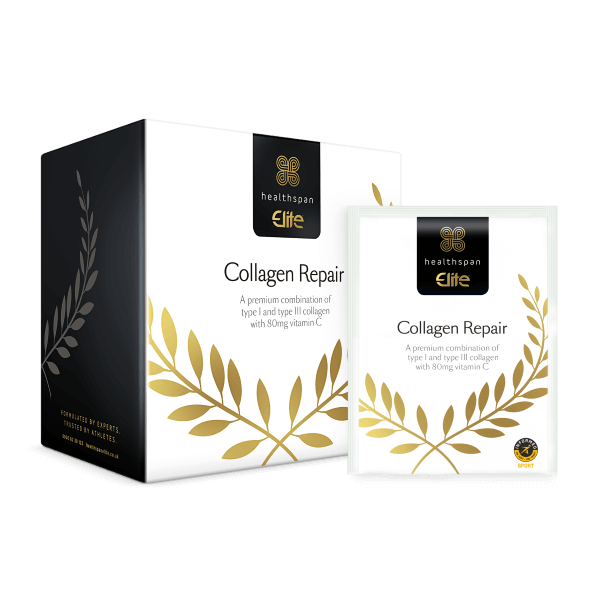In athletes, given the amount of training they undertake, maintaining healthy connective tissue is a key component of everyday lives. Here Wendy Martinson discusses the role of collagen in the maintenance, repair and remodelling of connective tissue.
Why is collagen important?
Collagen is a major structural protein of ligaments, tendon, bone and cartilage. Maintaining the integrity of these connective tissues is critical to enabling physical movement and activity. Collagen itself is a protein that is rich in the amino acids glycine, hydroxyproline and proline, which are provided through our daily food intake.1
Collagen is one of approximately 300 proteins that make up the complex system of the extracellular matrix (ECM) that gives structural and biochemical support to the surrounding connective tissue.2 Good nutrition and exercise are fundamental in maintaining the function of this matrix.
How does collagen supplementation work?
First and foremost, a good diet is crucial to provide the right balance of macro- and micronutrients that the body needs to stay healthy and function normally. This is especially important for athletes undertaking a challenging training program. However, there may be specific periods of time, during injury for example, when supplementation may be beneficial to help support repair and remodelling of the injured tissues.
Although there is still much more work to be done in this area, current research does suggest that supplementing with hydrolysed collagen or gelatin and vitamin C will provide the amino acid building blocks that may promote greater collagen synthesis in connective tissue.3, 4 Vitamin C acts as a co-factor; this means it is required for the activity of the enzyme involved in the production of hydroxyproline, which is one of the major proteins found in collagen.5
There have been several studies looking at the impact of collagen supplementation on connective tissue. One study observed thickened knee cartilage in osteoarthritic patients when supplementing with 10g collagen hydrolysate over a 6-month period.6 Another study reported a decrease in knee pain in athletes taking 10g collagen hydrolysate daily over 24 weeks.7
More recent studies looked at the effect of different preparations of collagen supplements on collagen synthesis rate in bone. Subjects took 15g collagen enriched with 48mg vitamin C, either as a drink containing gelatin or hydrolysed collagen, or as a gummy containing equal parts of both.1
To load the musculoskeletal system and stimulate bone collagen synthesis, subjects did 6 minutes of continuous jump rope 1 hour after consuming the supplement. After another 4 hours blood levels of Procollagen 1 N-terminal Propeptide (PINP) were measured. Procollagen 1 N-terminal Propeptide (PINP) is generally used as a marker of bone metabolism due to its high turnover rate, and so was measured to represent bone collagen synthesis.
Results showed firstly that the components of the collagen supplements were absorbed, as levels of glycine, lysine, proline, hydroxyproline and hydroxylycine were all elevated in the blood at the 1-hour time point after consumption. Earlier studies have also shown blood levels of collagen-specific amino acids to increase following collagen hydrolysate supplementation.8, 9
Secondly, changes in PINP levels suggested that collagen synthesis increased approximately 20% (although not statistically significant) from baseline in the gelatin and hydrolysed collagen groups, but not in the gummy (authors suggested this may be due to a lack of vitamin C which could have been deactivated due to heat exposure) or placebo group 4 hours after completing the 6-minute jump rope.
Previous work done looked at collagen synthesis in bone but also in engineered ligaments. The randomised crossover study was designed to compare the impact on collagen synthesis of a supplement containing either 0g, 5g or 15g gelatin with 48mg vitamin C taken 1 hour before the 6-minute rope skipping to load the musculoskeletal system.10
Those subjects consuming 15g gelatin showed twice the collagen synthesis, measured through serum propeptide levels, as either placebo or the 5g group. When serum from the subjects with increasing doses of gelatin was added to engineered ligaments for 6 days there was a corresponding increase in collagen content.

Elite Collagen Repair
Type I and type III collagen in an orange-flavoured drink
- 20g type I and type III hydrolysed collagen per serving
- 80mg added vitamin C to support cartilage formation
- Collagen plays a vital role in tendons and ligaments
What collagen supplementation strategy could you use?
If you have an injury or niggle in your joints or connective tissue, then first of all make sure you are eating regularly with good sources of protein (including leucine-rich sources), essential fats, vitamin C, zinc, copper and calcium to name a few of the key elements involved in healing and repair. Plan your meals and use the spare time you may have, if not able to train as much, to try some new recipes.
In addition to establishing a good meal pattern, specific supplementation may be beneficial. There is growing evidence that combining specific loading exercise (make sure you get advice on this) with nutritional interventions may provide the stimulus to the cells of tendons or ligaments to increase collagen synthesis and promote healing.10, 11, 12 Such interventions include supplementing the diet with hydrolysed collagen or gelatin, both of which contain specific amino acids required for collagen synthesis, alongside vitamin C.
Exercise stimulates blood flow, and so timing nutrient ingestion before exercise is important to enhance nutrient delivery to the injured site, as generally blood flow to inactive tendons and ligaments is limited. This will also take advantage of the cellular processes activated by the exercise stimulus in order to maximise collagen synthesis.12, 13
In summary, current evidence suggests that starting an exercise bout 60 minutes after consuming ~10g collagen hydrolysate or 15g gelatin with 50mg vitamin C results in greater collagen synthesis in the recovery period after exercise.










